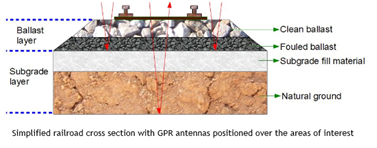Railway Engineering
Railway Engineering
 Providing very useful information for the appropriate route design of the railway track
Providing very useful information for the appropriate route design of the railway track
Geo-analysis applying several geophysical methods for railway engineering such as
- The electrical resistivity tomography (ERT) and the
- Ground penetrating radar (GPR).
The results of geophysical investigation prior to construction are highly advantageous as they provide very useful information for the appropriate route design of the railway track and the soil layers up to the desired depth.
Sub-trackbed investigation
Geophysical methods can be used to assess ground conditions, for example by profiling soil and rock layers, mapping groundwater variations and mapping variations in stiffness. Surveys can detect cavities such as solution features or mineworkings.
Main advantages :
- In the design phase for the profiling and stratification of the soil where the railway track is supposed to pass
- In the final acceptance of new constructed or existing tracks after substructure rehabilitation